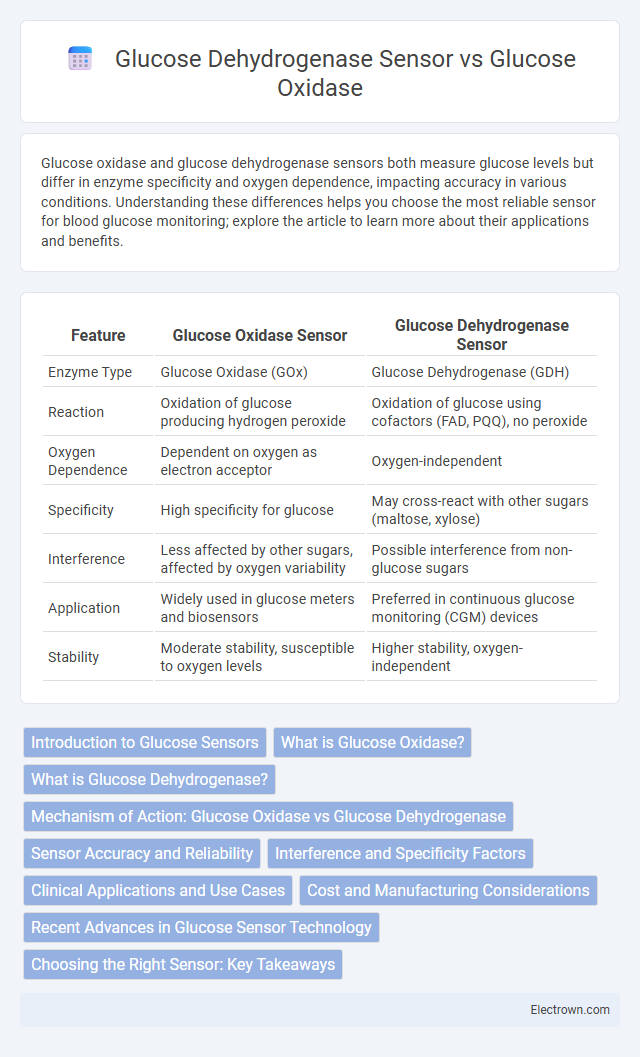Glucose oxidase and glucose dehydrogenase sensors both measure glucose levels but differ in enzyme specificity and oxygen dependence, impacting accuracy in various conditions. Understanding these differences helps you choose the most reliable sensor for blood glucose monitoring; explore the article to learn more about their applications and benefits.
Table of Comparison
| Feature | Glucose Oxidase Sensor | Glucose Dehydrogenase Sensor |
|---|---|---|
| Enzyme Type | Glucose Oxidase (GOx) | Glucose Dehydrogenase (GDH) |
| Reaction | Oxidation of glucose producing hydrogen peroxide | Oxidation of glucose using cofactors (FAD, PQQ), no peroxide |
| Oxygen Dependence | Dependent on oxygen as electron acceptor | Oxygen-independent |
| Specificity | High specificity for glucose | May cross-react with other sugars (maltose, xylose) |
| Interference | Less affected by other sugars, affected by oxygen variability | Possible interference from non-glucose sugars |
| Application | Widely used in glucose meters and biosensors | Preferred in continuous glucose monitoring (CGM) devices |
| Stability | Moderate stability, susceptible to oxygen levels | Higher stability, oxygen-independent |
Introduction to Glucose Sensors
Glucose sensors utilize enzymes like Glucose Oxidase (GOx) and Glucose Dehydrogenase (GDH) to measure blood sugar levels accurately. GOx-based sensors rely on oxygen to catalyze glucose oxidation, while GDH sensors use cofactors such as FAD or PQQ for electron transfer, providing enhanced stability in low-oxygen environments. Understanding the differences between these sensors helps optimize Your glucose monitoring for diabetes management.
What is Glucose Oxidase?
Glucose Oxidase is an enzyme that catalyzes the oxidation of glucose to gluconolactone, producing hydrogen peroxide as a byproduct, which is commonly used in glucose sensors for blood sugar monitoring. This enzyme offers high specificity for glucose, making it ideal for accurate and reliable glucose measurements in medical diagnostics. Your glucose monitoring device might use Glucose Oxidase to ensure precise glucose level readings essential for diabetes management.
What is Glucose Dehydrogenase?
Glucose Dehydrogenase is an enzyme commonly used in glucose sensors that catalyzes the oxidation of glucose to glucono-d-lactone, producing electrons that generate an electrical signal proportional to glucose concentration. Unlike Glucose Oxidase, which requires oxygen as an electron acceptor, Glucose Dehydrogenase functions effectively in low-oxygen environments, providing more reliable glucose measurements in various conditions. Your choice of sensor affects accuracy and performance, especially in continuous glucose monitoring systems.
Mechanism of Action: Glucose Oxidase vs Glucose Dehydrogenase
Glucose oxidase sensors catalyze the oxidation of glucose to gluconolactone by transferring electrons to oxygen, producing hydrogen peroxide as a byproduct, which is then measured electrochemically. In contrast, glucose dehydrogenase sensors utilize coenzymes such as NAD+, FAD, or PQQ to oxidize glucose directly without relying on oxygen, resulting in distinct electron transfer pathways for signal generation. These mechanistic differences impact sensor accuracy, oxygen dependence, and stability in glucose monitoring applications.
Sensor Accuracy and Reliability
Glucose oxidase sensors exhibit high specificity and consistent accuracy due to their enzyme-catalyzed oxidation of glucose producing hydrogen peroxide, which is precisely measured electrochemically. Glucose dehydrogenase sensors demonstrate enhanced reliability in variable oxygen environments, maintaining accurate glucose readings since they do not rely on oxygen as a co-substrate. Sensor stability and reduced interference from substances like maltose contribute to the superior performance of glucose dehydrogenase sensors in clinical glucose monitoring devices.
Interference and Specificity Factors
Glucose oxidase sensors exhibit high specificity for b-D-glucose but are susceptible to interference from oxygen levels since their enzymatic reaction relies on oxygen as an electron acceptor, impacting accuracy in low-oxygen conditions. Glucose dehydrogenase sensors, using co-factors like PQQ or FAD, offer greater resistance to oxygen interference and broader substrate specificity, which can sometimes reduce selectivity due to cross-reactivity with other sugars such as maltose and galactose. Your choice between these sensors should consider the operating environment and potential interfering substances to ensure accurate glucose monitoring.
Clinical Applications and Use Cases
Glucose oxidase sensors are widely used in clinical settings for continuous glucose monitoring due to their high specificity and reliability in detecting blood glucose levels, especially in diabetic care. Glucose dehydrogenase sensors offer advantages in environments with variable oxygen levels and are preferred in applications like point-of-care testing and critical care monitoring where accurate readings under fluctuating conditions are essential. Your choice between these sensors depends on the clinical application requirements, such as sensitivity to oxygen interference and the need for rapid, precise glucose measurement.
Cost and Manufacturing Considerations
Glucose oxidase sensors are generally more cost-effective to manufacture due to the widespread availability of the enzyme and well-established production methods. In contrast, glucose dehydrogenase sensors often involve higher material costs and more complex fabrication processes, driven by the enzyme's specificity and stability requirements. Manufacturing scalability favors glucose oxidase sensors, making them the preferred choice in cost-sensitive markets.
Recent Advances in Glucose Sensor Technology
Recent advances in glucose sensor technology highlight the enhanced specificity and stability of glucose oxidase (GOx) sensors, which use oxygen as an electron acceptor, reducing interference in blood glucose monitoring. Meanwhile, glucose dehydrogenase (GDH) sensors exhibit versatility by utilizing coenzymes such as PQQ, FAD, or NAD, enabling measurements in low-oxygen environments and improving accuracy in continuous glucose monitoring systems. Innovations in enzyme immobilization, nanomaterial integration, and signal transduction have further optimized both GOx and GDH sensors for real-time diabetes management applications.
Choosing the Right Sensor: Key Takeaways
Glucose Oxidase sensors rely on oxygen for glucose detection, making them sensitive to varying oxygen levels, while Glucose Dehydrogenase sensors use cofactors like NAD or PQQ, providing higher specificity and less oxygen dependency. Choosing the right sensor depends on your application environment, sensor accuracy needs, and the impact of interfering substances on readings. Understanding these differences ensures optimal glucose monitoring performance tailored to your requirements.
Glucose Oxidase vs Glucose Dehydrogenase Sensor Infographic

 electrown.com
electrown.com